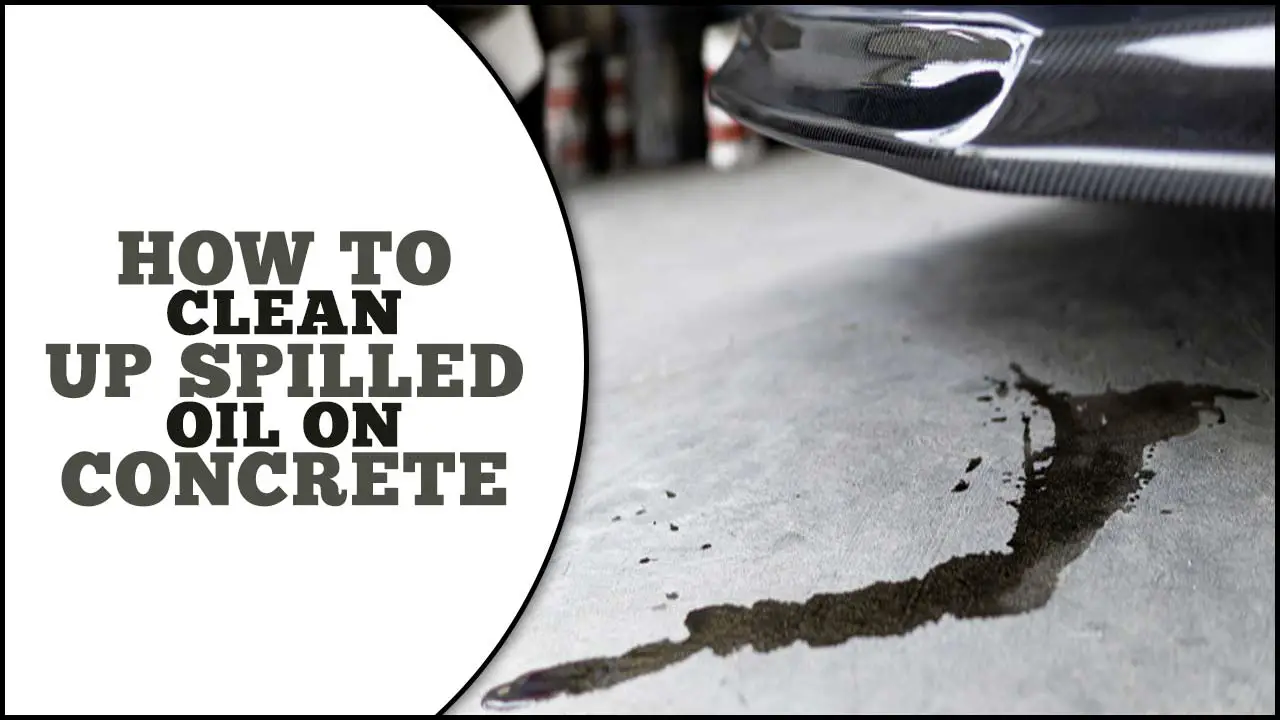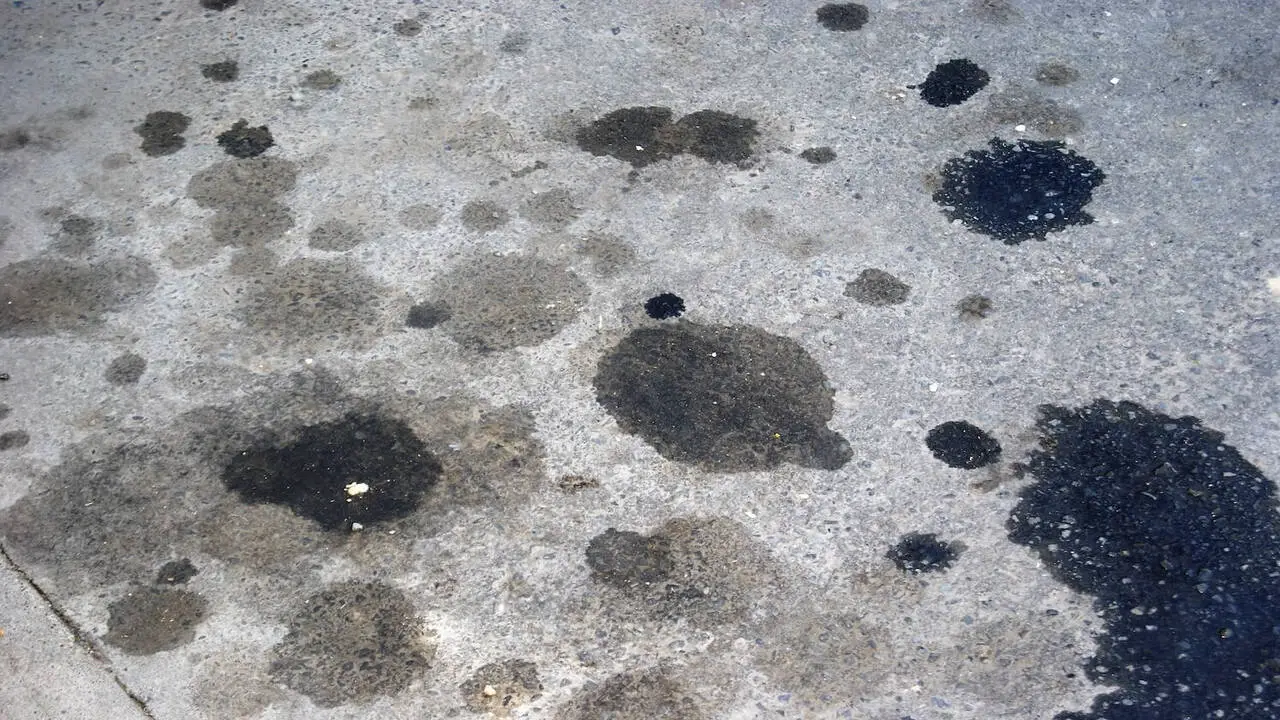Spilling oil on concrete can be a nightmare for many homeowners and businesses alike. Not only can it be hazardous to the environment, but it can also cause damage to the surface on which it’s spilled.
Cleaning up spilled oil on concrete can seem like a daunting task, but with the right tools and techniques, it can be done quickly and efficiently.
Here we’ll discuss how to clean up spilled oil on concrete, from the initial steps of containing and absorbing the spill to the final steps of cleaning and restoring the affected area. Whether you’re dealing with a small spill or a large one, our tips and tricks will help you get the job done right.

Importance Of Cleaning Up Spilled Oil On Concrete

You should not take lightly the important task of cleaning up spilled oil on concrete. Oil spills can cause significant harm to the environment and human health and safety. Spilling oil on concrete can seep into the pores of the surface, making it difficult to clean and potentially causing long-term damage. It’s important to act quickly when a spill occurs, as the longer the oil sits, the more difficult it becomes to remove.
There are many reasons why it’s important to clean up spilled oil on concrete. Firstly, oil can be a major safety hazard. Slippery oil can cause slip-and-fall accidents, leading to serious injury. Secondly, oil spills can be harmful to the environment. If left untreated, spilled oil can contaminate soil, waterways, and other natural resources, causing significant damage to local ecosystems and wildlife.
Safety Precautions Before Starting The Clean-Up Process
When dealing with spilled oil on concrete, it is important to take safety precautions before starting the clean-up process. This is because oil spills pose a serious risk to human health and the environment. Ensure that you ventilate the area well to avoid inhaling fumes that can harm your health as one of the first things to do. Additionally, wearing protective clothing such as gloves, boots, and goggles is essential to prevent skin contact and eye irritation.
- Wear protective clothing, such as gloves, boots, and safety glasses
- Turn off all sources of ignition in the area, such as cigarettes, matches, and open flames
- Ventilate the area by opening windows or using fans to prevent the buildup of potentially harmful vapors
- Use absorbent materials, such as kitty litter or sand, to soak up the spilled oil
- Dispose of the contaminated absorbent materials properly in accordance with local regulations
- Clean the affected area thoroughly with a degreaser or other appropriate cleaning agent
- Rinse the area with water and use a wet/dry vacuum to remove any remaining liquid
- Store any leftover cleaning materials in a safe and secure location away from heat sources and open flames
Tools And Materials Needed For Clean-Up

Knowing the materials needed for clean-up is crucial for ensuring the process is effective and efficient. Firstly, it ensures that you clean safely and appropriately. For example, if you are cleaning up a chemical spill, you must know the specific materials required to handle the spill safely, such as protective clothing, gloves, respirators, and absorbent materials.
Using the wrong materials or not having the right ones can lead to further harm and damage. Secondly, knowing the materials needed for clean-up can help to save time and cost. If you know the right materials, you can avoid wasting time and money on ineffective methods. For instance, cleaning up a large oil spill requires the right gear, such as booms and skimmers, to contain and recover the oil.
Tools
Cleaning up spilled oil on concrete can be a daunting task, but with the right tools, you can effectively remove the stain. Here are some essential tools you will need for the clean-up process. Remember, it is important to act quickly when dealing with spilled oil on concrete, as allowing it to sit for too long can make it more difficult to remove.
- – Scrub brush
- – Detergent or degreaser
- – Pressure washer
- – Protective gear
Absorbent Materials
When it comes to cleaning up spilled oil on concrete, using absorbent materials can be extremely helpful. Here is a list of absorbent materials that you can use to effectively clean up the spill. Remember, when cleaning up an oil spill on concrete, it’s important to act quickly to prevent any permanent damage or staining.
- Kitty litter
- Sawdust
- Baking soda
- Oil-absorbent pads
Cleaning up spilled oil on concrete can be a daunting task, but with the right cleaning agents, it can be made much easier. Here are some effective cleaning agents that can help remove oil stainshttps://briskhand.com/remove-motor-oil-from-concrete/ from concrete. Remember to always test any cleaning agent on a small, inconspicuous area of the concrete before applying it to the entire stain.
- – Dish soap
- – Baking soda
- – Cat litter
- – Commercial degreaser
Personal Protective Equipment (PPE)
Personal protective equipment (PPE) is essential in ensuring the safety and well-being of individuals who work in hazardous environments. It is critical to know the importance of PPE to protect oneself from harm, illness, or injury. PPE is necessary for various industries, including construction, healthcare, manufacturing, and emergency services. These industries have hazards, and PPE protects workers from risks.
- Gloves: Chemical-resistant gloves made of nitrile or neoprene are the best option for handling oil on concrete.
- Eye and face protection: Safety goggles or a face shield should be worn to protect against splashing oil.
- Footwear: Slip-resistant, closed-toe shoes or boots are recommended to prevent slips, trips, and falls.
- Clothing: Wear long sleeves and long pants that cover the skin to prevent skin contact with oil.
- Respiratory protection: An N95 filtering facepiece respirator should be worn to protect against inhaling oil mist or vapors.
- Hard hat: A hard hat should be worn if working in an area with a risk of falling debris.
- Apron or coveralls: Wear disposable or washable coveralls or an apron to prevent contamination of clothing.
How To Clean Up Spilled Oil On Concrete: Step-By-Step Process

It is crucial to know how to clean up spilled oil on concrete because oil spills can cause damage to the environment and pose a risk to human health. Oil spilled on concrete can seep into cracks and pores, making cleaning difficult and leading to long-term damage.
If left untreated, the oil can contaminate nearby soil and water sources, affecting the ecosystem and harming wildlife. In addition, oil spills can create hazardous conditions for workers and anyone in the area, as the oil can make surfaces slippery and increase the risk of falls and injuries. Here are the step-by-step guideline to to clean up spilled oil on concrete:
Step 1: Contain The Spill

When dealing with a spilled oil on concrete, it is important to take immediate action to prevent the oil from spreading and causing further damage. The first step in cleaning up the spill is to contain it.
This can be done by using absorbent materials such as kitty litter or sawdust to create a barrier around the spill. Sprinkle the absorbent material generously over the oil and gently press it into the surface of the concrete. Allow it to sit for a few minutes to absorb as much oil as possible before carefully sweeping it up and disposing of it properly.
Step 2: Absorb The Oil
Spilled oil on concrete is a common problem, especially in garages and driveways. The key to cleaning it up is to absorb the oil as quickly as possible. One effective method is to use cat litter or baking soda to absorb the oil.
Pour the absorbent material over the spill, covering the entire area. Let it sit for at least 30 minutes to allow the material to soak up the oil. Once it has absorbed as much oil as possible, use a broom or dustpan to sweep up the material and dispose of it properly.
Another option is to use a commercial absorbent product specifically designed for oil spills. These products usually come from recycled materials and are environmentally friendly. They encapsulate the oil and turn it into a solid, which makes it easy to sweep up and dispose of.
Step 3: Apply The Cleaning Agent
After containing and removing as much of the spilled oil as possible, the next step in cleaning up spilled oil on concrete is to apply a cleaning agent. There are several options for cleaning agents that can effectively break down and remove oil stains from concrete. One common choice is a degreaser or dish soap mixed with warm water.
Apply the mixture directly to the stained area and use a scrub brush or broom to agitate the solution and work it into the stain. Allow the cleaning agent to sit on the stain for a few minutes to penetrate and break down the oil. Then, rinse the area thoroughly with clean water to remove any residue. Repeat this process if necessary until the stain is fully removed.
Step 4: Scrub The Area With A Brush

When you ever find yourself dealing with a spill of oil on concrete, don’t panic. There are ways to clean it up effectively. One of the most effective methods is to scrub the area with a brush. Start using an absorbent material such as cat litter or sawdust to soak up as much oil as possible. Once the oil has been absorbed, sweep the material into a dustpan and dispose of it in a proper container.
Then, pour a generous amount of liquid dish soap over the remaining spill. After letting the soap sit for several minutes, use a stiff-bristled brush to scrub the area vigorously. Be sure to work in a circular motion to loosen the oil from the concrete surface. Repeat rinsing the area with water until the oil has been completely removed.
Step 5: Rinse The Area With Water
When you spill oil on concrete, it’s important to act fast to prevent it from seeping into the porous surface. The first step in cleaning up the spill is to absorb as much of the oil as possible with a clean, dry cloth.
Once you’ve removed the excess oil, sprinkle a baking soda over the affected area and let it sit for a few minutes. Baking soda is a natural absorbent that can help lift the remaining oil from the concrete.
After a few minutes, use a stiff-bristled brush to scrub the baking soda into the concrete. Then, rinse the area with water to remove the baking soda and any remaining oil residue. Always read the instructions on the product carefully and follow all safety precautions. Once you’ve rinsed the area with water and removed all traces of oil, let the concrete dry completely before walking or driving.
Step 6: Repeat The Process If Necessary
Cleaning up spilled oil on concrete can be challenging, but it is essential to prevent slips and falls. Start by blotting up as much oil as possible with a clean, absorbent cloth. Next, sprinkle a generous amount of baking soda or cat litter over the affected area and let it sit for at least 30 minutes to absorb the remaining oil.
Use a stiff-bristled brush to scrub the surface vigorously, focusing on the areas with the most significant stains. Once you have removed as much of the oil as possible, rinse the area thoroughly with hot water. Repeat the process if necessary until the oil stain is no longer visible. If you are dealing with a large spill or a particularly stubborn stain, you can use a commercial degreaser or hire a professional cleaning service.
Step 7: Dry The Area
When you’ve ever spilled oil on concrete, you know how much of a headache it can be to clean it up. Luckily, there’s a simple solution: dry the area. The first step is to contain the spill using a barrier like sand or kitty litter. This will help prevent the oil from spreading and making an even bigger mess.
Once you contain the spill, cover the affected area with a layer of absorbent material like baking soda or cornstarch. These materials will help soak up the oil and make it easier to clean. Let the material sit on the oil for at least 15 minutes or until it appears saturated. Use a broom or brush to sweep and discard the material after it has absorbed the oil.
Tips For Effective Clean-Up
People often overlook the essential life skill of effectively cleaning up after themselves. Knowing why clean-up is necessary is important because it can significantly impact your health, the environment, and even your social life. For example, failing to clean up after cooking can lead to the growth of harmful bacteria that can cause foodborne illnesses.
- Act fast and clean the spill immediately
- Absorb the oil from the surface using a cloth or paper towel
- Sprinkle an absorbent material such as baking soda, cornstarch, or cat litter over the affected area
- Let the material sit for at least 30 minutes to absorb the oil
- Sweep up the material and dispose of it properly
- Use a degreaser, soap, and water to clean the remaining oil stains on the concrete surface.
- Scrub the area with a brush and rinse it thoroughly with water
- Repeat the process if necessary until the oil stain is completely removed
- Consider using a sealant on the concrete surface to prevent future oil stains.
How To Prevent Oil Spills On Concrete Surfaces In The Future

Preventing oil spills on concrete surfaces in the future is important to maintain a clean and safe environment. Here are some tips to help you prevent oil spills. By following these preventative measures, you can significantly reduce the risk of oil spills on concrete surfaces and minimize their environmental impact.
- Use drip pans or trays underneath vehicles or machinery that may leak oil.
- Regularly inspect equipment and machinery for leaks and address any issues promptly.
- Store oils and other hazardous materials in secure containers to prevent accidental spills.
- Train employees on proper handling and storage procedures for oils and other hazardous materials.
- Install absorbent mats or pads in areas where oil spills are more likely to occur, such as near fueling stations or maintenance areas.
- Clean up any spills immediately using absorbent materials and dispose of them properly.
Conclusion:
Cleaning up spilled oil on concrete may seem daunting, but it can be accomplished effectively with the right tools and techniques. Remember to act quickly, contain the spill, and use absorbents or cleaning solutions that are safe for the environment and the concrete. Also, proper disposal of contaminated materials is crucial to prevent further environmental damage.
By following these steps and taking the necessary precautions, you can successfully clean up spilled oil on concrete and maintain a safe and clean work or living environment. If you read the above outline properly, we hope you understand how to clean up spilled oil on concrete.
FAQs
What Are The First Steps To Take When Cleaning Up Spilled Oil On Concrete?
The first steps are to contain the spill and absorb as much oil as possible with absorbent materials, such as kitty litter or sawdust. Next, it’s important to properly dispose of the contaminated absorbent materials. This can be done by contacting your local hazardous waste disposal center or using a licensed waste disposal company.
Are There Any Precautions That Need To Be Taken When Cleaning Up Spilled Oil On Concrete?
Yes, wearing protective gloves and eyewear is important to avoid skin contact and eye irritation while cleaning up spilled oil on concrete. It is also important to ensure that the area you are working in is well-ventilated to avoid inhaling any harmful dust particles.
How Can I Prevent Oil Spills On Concrete Surfaces In The Future?
To prevent oil spills on concrete surfaces, use drip trays under machinery and vehicles, and avoid storing oily items on concrete surfaces. Additionally, regular cleaning and sealing of concrete surfaces can help prevent oil absorption and make cleanup easier in case of spills.
How Do I Remove The Oil Stain From Concrete After Absorbing The Oil?
Use a heavy-duty concrete cleaner or degreaser to clean the stained area. Apply it on the stain and let it sit for a few minutes before scrubbing with a hard-bristled brush. Rinse and repeat the process if needed.
What Are Some Eco-Friendly Ways To Clean Up An Oil Spill On Concrete?
Use natural alternatives like baking soda, vinegar, or even Coca-Cola. Sprinkle baking soda or pour vinegar over the spill area and let it sit for a few minutes before scrubbing with a brush. You can pour Coca-Cola over the oil stain, leave it for a few hours, and then scrub and rinse the area.

I am passionate about tools and electric work. I love finding new tools and experimenting with them.

